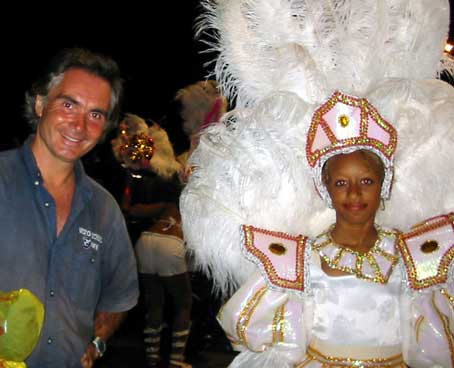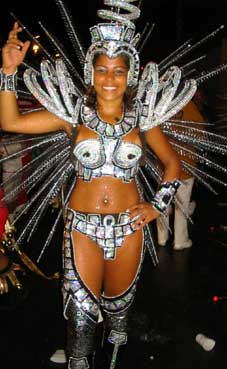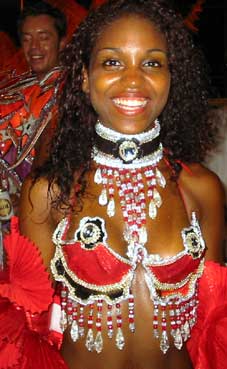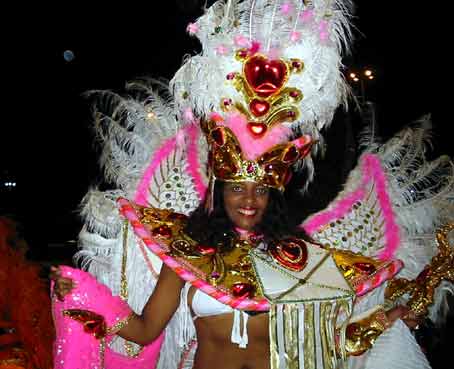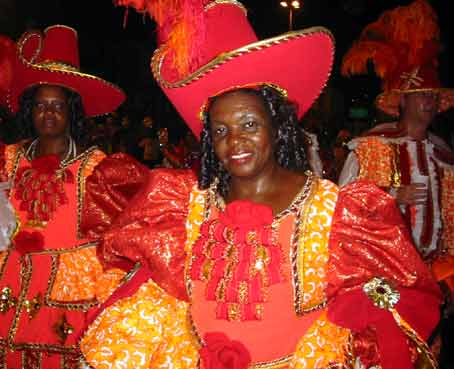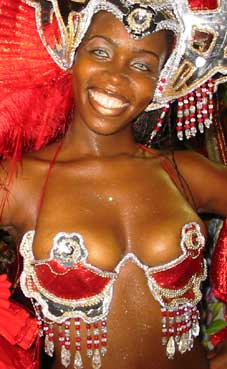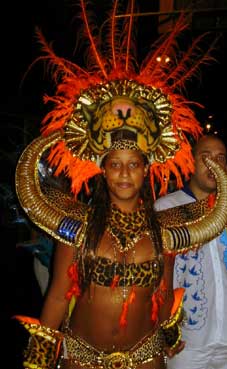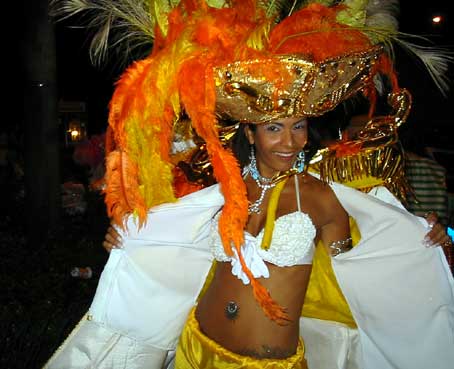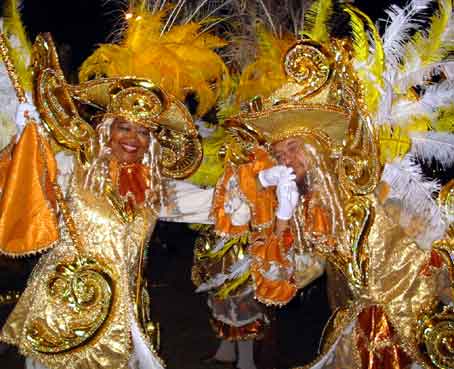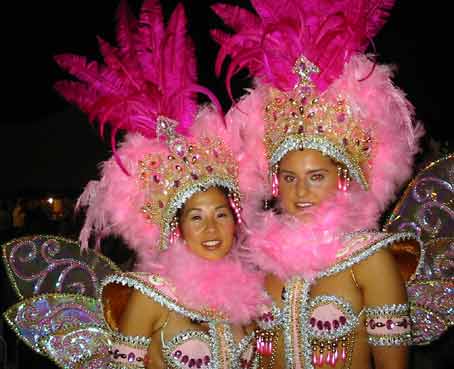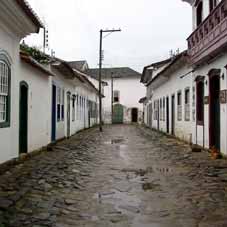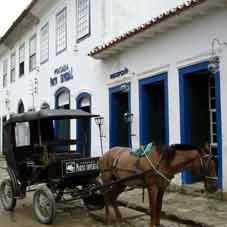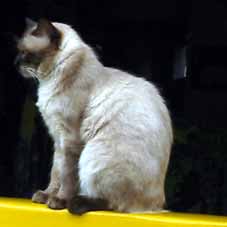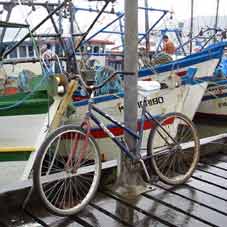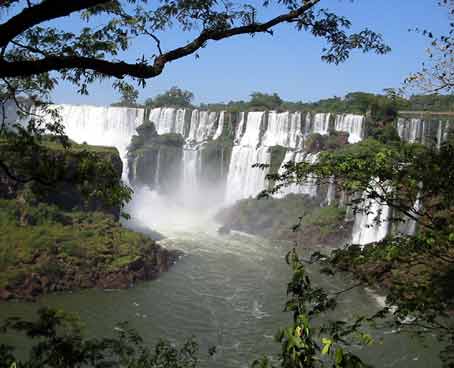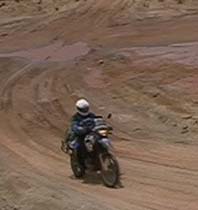
Sunday,
15 February 2004.
The border to Brazil was only 700km away from Santa Cruz (Bolivia). Usually
I would not think twice about such a distance but when you have absolutely no
idea about the condition of the road, you start to worry. I knew that it was
unpaved and that it was sometimes unpassable in the raining season. We were
right in the middle of the raining season. There is a longer and better way
to Brazil via Argentine but it is twice or three times as long and with the
Carnaval of Rio less than a week away I had no other alternative. I kept
on asking people in Santa Cruz about the condition of the road but no one could
give me any information. People travelling that way always take the train. The
dirt road is only used by trucks.
I set out early for two reasons; to try to cover as much ground as possible
and to take advantage of the cooler temperature. The first 100km were no problem;
I was able to ride at over 90km/hour. Eventually, I saw a truck coming from
the opposite direction; I stopped it and asked the driver for road condition.
It told me that it had rained a lot 4 days earlier but that the road was starting
to dry. Some of the rivers were quite high but they should get lower by the
time I reached them. I was quite relieved when he assured me that I should get
through quite easily if the rain stayed away. My enthusiasm was lowered a little
when his wife put her hand on mine and said "Please, be very careful".
We said good-bye and I left in a cloud of dust. The road got progressively worse
and worse. Big holes forced me to slow right down. I arrived in San José
at lunch time, having covered nearly 300km. I was very happy with my progress.
I asked another truck driver how was the road from now on. "Much better"
he said. I did not take me long to find out what he met. It was probably much
better for him but not for me. The rocks and the stones had been replaced by
lots of sand and soft sand. Of course, for a truck it would be much better but
on a bike, it is hell. With all the weight that I am carrying it is nearly impossible
to ride it. I was going extremely slow and I fell twice without any damage.
I reached the small town of Robore and I decided to call it a day. I had covered
another 150km in 6 hours. The heat and the hard work had exhausted me. I slept
like a baby that night. I left a dawn the following morning. I only had 250km
to go and I was feeling optimist. Again, the sand made it tough and soon I had
rivers to cross. I would stop in front of it and try to guess how deep it was
but there was no way to tell and no one around to ask. The rocks at the bottom
of it worried me as well. If my front wheel hit one I would probably lose balance
and fall in the water, luggage and bike. Every time, I attacked it aggressively
and every time made it to the other side. Sometimes the water would reach the
level of my tank and the engine would be under water but the bike never coughed
once. I have to admit that the BMW GS650 Dakar is quite a bike. I had absolutely
no trouble in very high altitude, the consummation is fantastic, and I still
get over 100 km with 4 lt. After over 60,000km the oil level stay the same from
one oil change to the other. After all that hard riding on dirt road, nothing
has broken down yet apart from the rear shock absorber. I definitely would recommend
it for anyone thinking of going on
an
overland trip. Riding 250km on that kind of road
is very tiring because you cannot relax for one second. There is always some
sand, mud or rivers to keep you busy. I finally arrived at the border in mid
afternoon. I really did enjoy Bolivia. The friendly people and the amazing sceneries
were definitely the highlights but the low cost is appreciated as well.
Crossing the border was done in a minute. All I did was to get an exist stamp
in my passport and I was told to stop in the first town in Brazil and to get
my entry stamp from the federal police. I did not see any custom so I did
not
worry about any papers for the bike; no doubt I will have to deal with that
later.
The first town in Brazil is Corumbá. This port of 86,000 people
on the Rio Paraguay has a reputation for poaching and drug trafficking but that
was not going to worry me. I did visit the police station to get my entry stamp
and then changed some money and got the bike ready for the next stage.
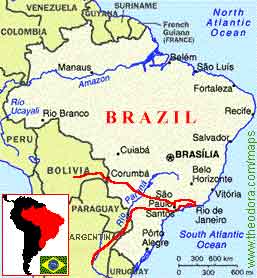
Here
is some information about Brazil for some of you. It is the world's fifth-largest
country, after Russia, Canada, China and the USA. With a population of more
than 170 million, it is also the fifth most populous country after China,
India (maybe India has pass China by now) USA and Indonesia (not 100% sure about
Indonesia, maybe you could check it out and let me know). I was surprise to
know that there were only 14 million people in Brazil in 1890 and 70 million
in 1960 but now, the birth rate has dropped. As you might or might not know
Brazil is the only country in South America not to speak Spanish, they speak
Portuguese. The capital is Brasilia.
Brazil's
economy is the ninth largest in the world. It's the world largest producer of
coffee and biggest exporter of sugar, second largest of soy and third largest
of beef. Yet Brazil also has many peasants living at subsistence level, and
millions with no land at all. Just 1% of landowners own nearly half the cultivable
land, and around 40% of cultivable land is not cultivated. Wealthy Brazilians
live in luxurious houses behind high walls protected by armed guards. Poor Brazilians
live in the slums or on the streets of the same cities or try to eke subsistence
from the land or waters around their rural shacks.
Apart from its mad, debauched hedonism of Carnaval or the enormity of Amazonian's
rain forests and rivers, Brazil is also well known for its football (soccer)
and its Formula One drivers (Ayrton Senna, Nelson Piquet and Rubens
Barrichello to name just a couple). There are also its hundreds of superb
beaches and its intense musicality and rhythm.
The roads in Brazil, unlike Bolivia, are all paved and that was good news for
me. The next day I went through the Pantanal region. The Pantanal is
a huge 230,000 sq Km wetland area straddling Brazil, Paraguay and Bolivia. It
has the greatest concentration of fauna in the new world. Altogether the Pantanal
supports 650 bird species and 80 mammal species, including jaguars, ocelots,
pumas, maned wolf, deer, anteaters, armadillos, howler and capuchin monkeys.
I was so happy to be on a good road that I did not really look for
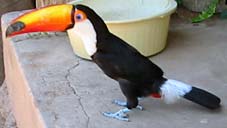
animals, the only bird that I saw was a Tulcan
(photo). Still, the scenery was lovely and I would have loved to take a closer
look but I knew that I was going to see more birds in Rio anyway. That day I
covered 850 km without incident.
The following day was another painful 890 km. I am using the word painful because
spending 12 hours on
a
motorbike, on a very boring road, is the perfect word to describe it. No mountains,
no beaches, no fast curves to make the riding entertaining and no llamas to
wave to, just fields of soy. Likely, the highways are free of charge for motorcycles
but payable for any other vehicle. There were many police check points along
the way but they never stopped me. At
around
US$0.80 per litre, the petrol (or Gasolina as they call it here) is not cheap
but seemed to be good quality. I find this picture quite amusing (right). It
seems that in Brazil, you drink and drive and fill up at the same time.
I reached São Paulo in late afternoon and I was determined to
keep going and to spend the night as far as possible from it. An estimated 18
million people live in São Paulo (nearly the total population of Australia).
To try to find a place to stay in such a city was not something that I
was prepared to do. The freeway surrounding
the city was packed and it took me close to two hours to get out. By then,
it was getting dark and to make it more exciting I got soaked as I went through
a big storm. The freeway out of São Paulo was standing still due to
a road accident. I was getting anxious to find a place to stay. I existed
some 40 km out of town to the small town of Santa Isabella. I was confident
that I would find an adequate place to stay. After searching for a while I
found the only hotel in Santa Isabella. It was full. I got back on
the freeway and got forward going between trucks and cars. I saw a sign that
indicated a motel. I existed again but when I got to the motel I quickly understood
that it was not the kind of place I was looking for. Motels in Brazil are
places where locals go for quickies with their mistresses or girlfriends,
sometimes both. They hire the room for a couple of hours and go back to work
or to their wife (or husband) afterward. I decided that I needed a little
more time than that and that mirror on the ceiling were not something I was
desperately seeking. Driving at night in Brazil or in any developing countries
is hazardous because other drivers are more likely to be drunk and road hazards
are less visible. The number of fatalities caused by motor vehicles in Brazil
is estimated at 80,000 per year. The cult of speed is insatiable. Other painful
obstacles are the speed bumps. They must have the world's largest industry
of them and they are too large and often well-night invisible till it's far
too late. Those are the reasons why I was getting desperate to stop. I eventually
found a room somewhere further, in another small town and I was glad to find
out that I was only 380km from Rio de Janeiro.
Thursday, 19 February.
I arrived in Rio the next day at around lunch time. Finding a place to stay
in Rio at Carnaval time can be difficult without reservation but I was quite
lucky and found a cheap hotel right in the centre for US$10. Parking the bike
was a problem but the owner assured me that my bike would be fine in front
of the hotel as the night watcher would be there to keep an eye on it.
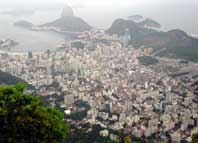
Rio
de Janeiro is the second largest city of the country. Seven million cariocas,
as its inhabitants are called, are jammed into the world's most beautiful city
setting (after Melbourne of course), between ocean and escarpment. Despite Rio's
enormous problems - poverty, violence, drug abuse, favelas (shantytowns), police
corruption - cariocas pursue pleasure like no other people: beaches and body
beautiful, samba and football, beer and cachaça (sugarcane
rum). I am told that
the sensuality of Carnaval is the best known expression of this Dionysian
spirit. By the way, Rio de Janeiro means January River.
Rio gets a lot of bad international press about crime and violence. Most probably
for good reasons and, as the Carnaval brings thousands of tourists; it brings
more thieves as well. Here are some precautions that I usually take in unsafe
cities.
1. I dress down (I usually don't have any other alternative anyway),
with casual clothes that blend in.
2. I keep small change and a few banknotes ready in a pocket so I don't
have to flash a wallet just to pay a bus fare.
3. I don't wander around with a camera in view or in a swanky camera
bag. I usually keep it in a local supermarket plastic bag.
4. I try to be observant and alert and I walk purposefully. If you
look dopey, hesitant and disoriented looking you can be sure that you will
attract criminals.
5. After dark, I never walk along empty or nearly-empty streets or
into deserted parks.
6. If I go to the beach, I don't take anything except my bathing suit,
a towel and just enough money for something to eat. No camera, Walkman or
bag.
7. I always check windows (if there are any) and doors of my room for
security, and I don't leave anything valuable lying around it.
8. When I use any ATM or exchanging money, I am always aware of those
around me. Robbers usually watch these places looking for targets.
Carnaval in Rio is the most famous party in
the world and that's exactly why I was there. Every year, foreigners descend
on Rio en masse to join the locals in partying till they drop. Some thieves
keep in the spirit of the season by robbing in costume. I did not care much
about the parties or joining the dancing throngs and the bandas (marching
bands) which tour the streets in the afternoon and early evening. What interested
me the most was the samba parades held in the sambodromo, a street
with purpose-built spectator stands. There, Brazilians
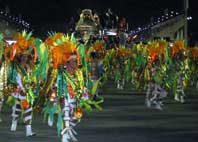
harness
sweat, rhythm, noise and confusion, and turn them into art. Each escola de
samba (samba clubs) has many super-elaborate tinselly floats, hundreds of
drummers and thousands of people singing and dancing, in costumes that can be
both extraordinarily lavish and extremely brief (my favorite) - from 1.5m feather
headdresses to rhinestone-studded G-strings. The big nights were Sunday and
Monday when Rio's 14 best escolas de samba did their stuff. I was
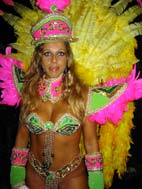
determined
to get there even though all the tickets were sold out already. They ranged
from US$50 to US$3000. The show starts at 9pm until 7 in the morning. I was
told to go there at around midnight, three hours into the show, and to buy a
ticket from a scalper. I went there but never bought a ticket, I just used my
press card and joined the media in the parade. Obviously, I had the best spot
that money could not buy. I enjoyed it so much that I stayed until 4am and returned
the next day for the same price (nothing). Outside the sambodromo, the streets
were full of locals who were dancing, drinking and having fun. The mix of people
were amazing, blacks,
whites,
Latinos, drag-queens, nearly-naked beautiful young girls and streets kids.
In the streets of Rio, the party goes on for a week. There are numerous stages
around the city with live bands playing hot music until late in the night. What
amazed me the most was to see how quick people started to dance, usually at
the first beat of a drum. The beer and other
alcoholic
drinks were a big part of the celebration.
I stayed in Rio for 6 days. One day, I went to the Corcovado. Corcovado
is the mountain and Cristo Redentor or Christ the Redeemer (pictured)
is the statue that gazes over Rio from its peak. The mountain rises straight
up from the city to 710m and usually the view is a spectacular panorama. That
day, it was overcast and foggy.
Wednesday, 25 February 2004
I left Rio early in the morning, glad to have all my equipment still with me,
in the direction of Parati. Parati, 280km southwest of Rio, is one of
Brazil's most enchanting colonial
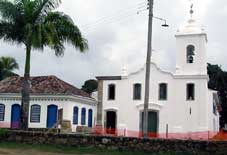
towns
(pictured) and is set on a shoreline of jutting peninsulas and secluded beaches
where steep, jungled mountains seem to leap towards hundreds of islands set
on clear, warm waters. That was a peaceful and ideal place to relax after Rio.
I found a decent hotel and went for a visit of the town. When I got back to
the hotel, someone had run into my bike with their car, causing some minor damage.
To top it all, it rained all afternoon. The next day was even worse, the rain
never stopped
and
everything looked miserable. The mountains were hidden by the clouds and those
were so low that they seemed to be touching the sea. I t looked so bad that
I thought that I would never see the sun ever again. A quick look at the weather
forecast in the newspaper was not encouraging either. From what I understood,
all southern Brazil was going to be very wet for a few days. I was not looking
forward to get back on the road but sometimes 'a man has to do what a man has
to do' so I planned to leave the following day no matter what.
I got up very early, in my raining gear, and went to get my bike. I could not
believe it, a perfect blue sky was waiting for me and a timid sun was rising
slowly. I did not lose any more time and set off. The road was following the
coast. On one side, I had the mountains covered with lush tropical rain forest
and on the other, a beautiful blue sea dotted with hundreds of small islands.
I followed the coast for 300km then I took the direction of Curitiba
where I stopped for the night. I had covered nearly 800km (and my bum was feeling
it) and got wet only once.
The next day, I made it all the way to Foz Do Iguaçu (680km and
a complaining arse). Again, I had a perfect sunny day with temperature averaging
30 degrees. For some reason the highway was payable for motorbikes this time
and it did not seem to be any other alternative road. I saw a couple of bad
accidents, where dead bodies were lying on the road. The traffic slowed down
but people did not seem to worry about it and sped away as soon as the cops
disappeared behind them.
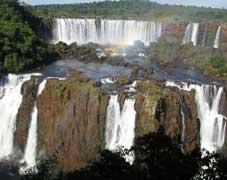
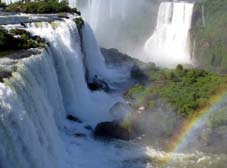
I
was here to see, once again, Brazil's most spectacular natural wonder, the astonishing
Iguaçu waterfalls. Paraguay, Brazil and Argentina meet at this point.
This is where the Rio Iguaçu plunges and crashes 80m in 275 different
falls. The legend says that Iguaçu falls originated when a jealous forest
god, enraged by a warrior escaping downriver by canoe with a young girl , caused
the riverbed to collapse in front of the lovers, producing a precipitous falls
over which the girl fell and at their base, turned into a rock. The warrior
survived as a tree overlooking his fallen lover. I don't know about you but
I don't buy it and I think that the falls' geological origins are a little more
prosaic. In southern Brazil, the Rio Iguaçu passes over a basalt plateau
that ends just above its confluence with the Paraná River. Where the
lava stopped, at least 1600 cubic meters of water per second plunge 80m into
the sedimentary terrain below. Before reaching the edge, the river divides into
many channels to form several distinctive cataratas.
The falls can be seen from Argentina (for a close look) or
from
Brazil (for a grand overview). The next morning I went to visit the Brazil side
then crossed the border into Argentina for a closer look. I had absolutely
no problem to cross the border but I don't know if I crossed it with pleasure
or with regrets. That was my final border, the end of my journey is close, I
only have to ride to Buenos Aires but you never know, many things could
happen then. So don't miss the conclusion of ride4kids, soon and right here.
Click here to view more photos.
JOURNAL 34.
02/03/04 . Brésil . Kilométrage
total 67,245km .
Pour revenir à la version française
du site, cliquez sur Français
Dimanche
15 Février 2004.
La frontière du Brésil se trouvait seulement à 700
Km de Santa Cruz (Bolivie). Habituellement une distance pareille ne m'inquièterai
pas mais quand on a aucune information sur l'état de la route, on se
pose quelques questions. Je savais qu'elle n'était pas goudronnée
et qu'elle pouvait être impassable en saison de pluie. Nous étions
en pleine saison des pluies. Il y avait bien un autre chemin à prendre
mais celui-ci, qui passait par l'Argentine, était trois fois plus long
et comme le Carnaval de Rio commençait 6 jours plus tard, je n'avais
pas le choix. Je demandais constamment aux gens de Santa Cruz s'ils connaissaient
les conditions de cette route mais personne ne pouvait me répondre de
façon certaine. En Général, les personnes qui utilisent
cette frontière, s'y rendent en train. Cette route n'est utilisée
que par les camions.
Je partais très tôt pour deux raisons; essayer de couvrir un maximum
de distance et aussi pour

utiliser
les températures plus fraîches du matin. Les cents premiers Km
étaient du gâteau; J'arrivais à rouler à plus de
90 Km/h par place et je me réjouissais de mes progrès. Eventuellement,
j'ai vu un camion qui venait de la direction opposée de la mienne et
je lui faisais signe de s'arrêter. Il le faisait bien gentiment et j'en
profitais pour lui poser quelques questions sur l'état de la route. Il
me disait qu'il avait beaucoup plu 4 jours plus tôt mais que la pluie
avait cessé et que le chemin commençait à sécher.
Il me soulignait aussi que beaucoup de rivières étaient très
hautes mais qu'elles devraient baisser d'ici mon passage. Tout cela me tranquillisait
beaucoup surtout quand il m'assurait que je ne devrais pas avoir trop de problème
si la pluie ne recommençait pas. Mon
enthousiasme
baissait quelques peu quand sa femme posait sa main sur la mienne en me disant
droit dans les yeux "Faites très attention à vous".
J'aurai aimé lui demander ce qu'elle voulait dire par là mais
je préférais le découvrir moi-même. Je repartais
dans un nuage de poussière après les avoir remercier. La route
empira progressivement. Des trous énormes me forçaient à
ralentir un maximum. J'arrivais à San José en début d'après
midi, j'avais déjà parcouru presque 300 Km. J'étais fier
de moi mais je m'inquiétais toujours sur la route à venir. Je
demandais à un autre routier comment était la route "Beaucoup
mieux" disait il d'un air très sûr de lui. Cela ne m'a
pas pris beaucoup de temps pour découvrir ce qu'il voulait dire. La route
était certainement mieux pour lui mais pas du tout pour moi. Les trous
et les cailloux avaient fait place à du sable, beaucoup de sable, du
sable mou. Bien sur, en camion, c'est beaucoup mieux mais en moto c'est l'enfer.
La cargaison de bagages
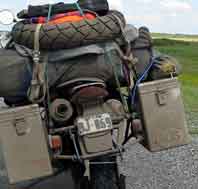
que je transporte n'arrangeait rien. La roue
avant de la moto se dérobe toute seule et puff! Tout le monde parterre.
J'avais beau roulé au pas je tombais quand même. J'arrivais dans
le petit village de Roboré en début de soirée et je m'installais
dans l'unique hôtel pour la nuit. J'avais ajouté 140 Km au compteur
en 6 heures de route.
Je repartais dés l'aube le lendemain matin. Il me restait environ 260
Km à parcourir et je me sentais optimiste. Encore une fois le sable me
ralentissait énormément et les rivières à traverser
étaient nombreuses. En général, je m'arrêtais devant
celle-ci en essayant
de
deviner la profondeur mais cela n'était guère possible et il n'y
avait personne à qui demandait. Les rochers invisibles au fond de ces
rivières m'inquiétaient beaucoup car si ma roue avant en heurtait
un je perdrais certainement mon équilibre et je me retrouverai dans l'eau.
L'idée de devoir repêcher ma moto et mes bagages dans 80cm d'eau
ne me réjouissait pas du tout. A chaque fois, j'attaquais la traversée
agressivement et en ressortais sain et sauf. Des fois, j'avais de l'eau jusqu'au
réservoir et bien que le moteur soit sous l'eau celui-ci n'a jamais toussait
une seule fois. Je dois admettre que la BMW GS 650 Dakar est parfaite
pour ce genre d'excursion. Même en haute altitude, je n'ai eu absolument
aucun problème et la consommation de carburant est fantastique. J'arrive
toujours, après 65,000 Km, à faire plus de 100 Km avec 4 litres
d'essence. Elle ne bouffe absolument pas d'huile du tout. Après toutes
les mauvaises routes que j'ai parcouru, rien n'a cassé, à part,
bien sur, l'amortisseur arrière. Je n'hésite pas à vous
la recommander si vous avez envie de faire le tour du monde.
Rouler dans des conditions pareilles n'est pas reposant car il n'est pas possible
de se relaxer une minute. Il y a toujours du sable, de la boue ou des rivières
pour vous garder sur la pointe des pieds. Je suis finalement arrivé à
la frontière vers 15 heures, content d'avoir réussi ce raide mais
aussi content de retrouver les routes asphaltées. J'ai vraiment adoré
la Bolivie. Les gens sympathiques et les paysages sublimes en ont fait un pays
remarquable à visiter et le prix si bas du coût de la vie le rend
encore plus intéressant.
Le passage de la frontière s'effectuait en une minute. Je donnais seulement
mon passeport à l'immigration pour qu'il me donne un tampon de sortie
de Bolivie et on me disait d'aller dans le bureau de police le plus proche pour
obtenir un tampon d'entrée dans le Brésil. Je ne voyais aucune
douane donc je ne me tracassais pas pour les papiers de la moto, nul doute que
je vais sûrement le payer cher plus tard.
Corumbá est la première ville du Brésil. Ce port
de 86,000 habitants sur la rivière Paraguay est réputé
pour sa contrebande et pour son trafic de drogue mais je n'allais pas m'inquiéter
pour ça. J'allais rapidement au bureau fédéral de police
pour mon entrée, changeais quelques dollars en Reais (monnaie
Brésilienne) et je préparais ma moto pour l'étape suivante.

Voici
quelques brèves informations sur le Brésil qui vous seront utiles
pour jouer à 'Qui veut être millionnaire. C'est le cinquième
plus grand pays du monde après la Russie, le Canada, la Chine et les
Etats-Unis. Avec une population de plus de 170 millions d'habitants,
elle se classe aussi au cinquième rang mondial après la Chine,
l'Inde, les Etats-Unis et l'Indonésie (Je ne suis pas certain à
100% pour l'Indonésie, peut-être pouvez vous vérifier et
me le faire savoir). J'étais assez surpris d'apprendre qu'il n'y avait
que 14 millions d'habitants au Brésil en 1890 et 70 millions en 1960,
maintenant le taux de naissance à beaucoup diminuer. Comme vous le savez,
le Brésil est le seul pays d'Amérique du Sud où la langue
principale n'est pas l'Espagnole mais le Portugais. L'économie
Brésilienne
est neuvième au niveau mondial. C'est le plus grand producteur de café
du monde et c'est aussi le plus grand exportateur de sucre, deuxième
de soja et troisième de bœuf. Néanmoins, Il y a des millions
de Brésiliens qui vivent dans la pauvreté. C'est Brasilia
la Capitale.
A part son Carnaval fou et ses énormes forêts et rivières
Amazoniennes, le Brésil est aussi célèbre pour son football
et ses pilotes de formule 1 (Ayrton Senna, Nelson Piquet et Rubens
barrichello sont parmi les plus connus). Il y a aussi ses centaines de
plages superbes et sa musique intense au rythme des danseuses de Samba.
Les routes du Brésil sont toutes goudronnées et ça c'était
une bonne nouvelle pour moi. J'attaquais le

lendemain
par la traversée du Pantanal. Le Pantanal est un marécage
immense de 230,000 Km/carré qui chevauche le Brésil, la Bolivie
et le Paraguay. On y trouve la plus grande concentration de faune du monde.
Le Pantanal supporte 650 différentes sortes d'oiseaux et 80 sortes d'animaux
comme les jaguars, pumas, loups, cerfs, mangeurs de fourmis et de singes. J'étais
tellement content d'être sur une belle route que
je
n'ai pas vraiment fait attention à la nature, je remarquais seulement
les oiseaux qui volaient devant moi. Ce jour là je dépassais les
850 Km sans problème.
Le lendemain c'était devenu une corvée, je refaisais 890 Km. J'utilise
le mot corvée parce que de passer 12 heures sur une moto, sur une route
sans intérêt, est le mot idéal pour le décrire. Pas
de montagnes, pas de plages, pas de virages rapides qui rendent la conduite
intéressante et pas de lamas à saluer au passage, juste des champs
de soja. Heureusement, grâce à Cloclo, je pouvais chanter à
tout tête 'Quand tu souris, je m'envole au paradis, je vais à
Rio, de Janeiro…'. En plus, les autoroutes sont gratuites pour les
motos ce qui n'est pas le cas pour tous les autres véhicules. Il y avait
aussi beaucoup de contrôle de police mais ils me faisaient toujours signe
de

continuer
sans m'arrêter. A 70 centimes (Euro) par litre, l'essence (ou gasolina)
n'est pas vraiment bon marché mais elle semble être de bonne qualité.
J'ai trouvé cette photo amusante (ci-contre). Il me semble que les Brésiliens
conduisent et boivent en même temps. "Quarante litres d'essence et
cinq litres de pinards, s'il vous plait! Ça devrait être suffissant
pour gagner São Paulo"
J'arrivais à São Paulo vers 16 heures mais je ne voulais
absolument pas y passer la nuit, je voulais à tout prix m'en éloigner
au maximum. La population de cette ville est de 18
millions d'habitants (presque la population
entière d'Australie) et de risquer d'y entrer pour trouver un hôtel
me paraissais invraisemblable. Le périphérique était
très chargé et frôlé le bouchonnement. Cela me
prenait 2 heures pour en sortir. Il commençait à faire nuit
et pour rendre les choses plus excitantes, un orage me tombait dessus. L'autoroute
qui m'emmenait vers Rio était bloquée par un accident (je l'appris
par la suite). De trouver une chambre pour passer la nuit était primordiale
et je commençais à m'inquiéter sérieusement. J'avançais
lentement en me faufilant entre les voitures, pas facile quand on prend en
compte la largeur de ma moto. Je prenais une sortie à 40 Km au nord
de São Paulo vers la ville de Santa Isabella. Après quelques
recherches je m'apercevais qu'il n'y avait qu'un hôtel et ce dernier
était complet. Je retournais sur l'autoroute, il faisait nuit mais
la pluie avait ralenti. Un peu plus loin j'apercevais une enseigne 'Motel'.
Je pensais être sauvé mais quand je l'ai finalement atteint je
me suite vite rendu compte que ce n'était pas exactement le sorte de
lit que je recherchais. Les motels, au Brésil, sont des endroits où
les Brésiliens vont rapidement pour une partie d' fesses avec leur
maîtresse ou leur secrétaire. Ils louent une chambre pour un
certain temps puis retournent au boulot ou près de leur épouse.
Comme ma secrétaire était occupée et que je n'avais pas
vraiment besoin de miroir au plafond pour dormir je reprenais la route.
Conduire la nuit au Brésil, ou dans n'importe quel autre pays en développement,
est hasardeux parce que les autres conducteurs risquent d'avoir bu un petit
coup et en plus, les obstacles sur les routes sont moins visibles (délicat
en moto). Le nombre de mort sur les routes Brésiliennes est de 80,000
par an. Un autre problème aussi ceux sont les dos d'ânes. C'est
une industrie qui doit faire fortune car elle est certainement la plus importante
au monde. C'est pour toutes ces raisons que trouver un hôtel était
important. J'en ai finalement trouvé un, dans une petite bourgade et
j'étais très heureux d'apprendre que je n'étais plus
qu'à 380 Km de Rio de Janeiro.
Jeudi 19 Fevrier.
J'arrivais à Rio le lendemain vers midi. De trouver une place dans
Rio quand c'est le carnaval peut être difficile, voir impossible, surtout
sans réservation mais la chance était de mon côté
et j'en trouvais un pour 10 Euros en plein centre ville.
Rio est la deuxième plus grande ville du Brazil. Sept millions de Cariocas
(habitants de Rio) sont entassés dans une des plus belles villes du
monde. Bien que Rio a des énormes problèmes - pauvreté,
violence, drogue, favelas et corruption (police surtout)- les Cariocas poursuivent
l'amusement comme personne: la plage, le football, la samba, la bière
et le cachaca (rhum à base de canne à sucre) sont dans la vie
de tous les jours. La traduction de Rio de Janeiro est 'Rivière de
Janvier'.

Rio reste quand même une ville violente
et dangereuse. Le carnaval n'arrange rien, il apporte encore plus de voyous
dans les rues. Voici quelques précautions que j'utilise quand je suis
dans des villes pas très sûre.
1. Je m'habille très simplement (je n'ai souvent pas le choix
de faire autrement, vous connaissez ma garde robe).
2. Je garde juste un peu de monnaie sur moi comme ça je n'ai
pas à sortir un portefeuille pour acheter un coca.
3. Je ne me promène jamais avec
mon appareil photo en pleine vue, je le mets dans un sac en plastique d'un
super marché local.
4. J'essaye d'être observant et alerte et je marche avec détermination.
Si vous semblez dans la lune, hésitant ou désorientez vous pouvez
être sûre que les voyous vont le remarquer et vous serez une proie
idéale.
5. La nuit, je ne me promène jamais le long de rues vides ou
dans des parques désert.
6. Si je vais à la plage (particulièrement à Rio),
je ne prend rien avec moi à part mon maillot de bain, une serviette
et de quoi acheter une boisson ou quelques choses à manger. Pas d'appareil
photo, walkman ou de sac.
7. Je vérifie toujours les fenêtres (s'il y en a) et la
porte de ma chambre par sécurité et je ne laisse rien de valeur
traîner.
8. Quand j'utilise un ATM ou que je change de l'argent, j'observe toujours
les gens autour de moi. Les voleurs surveillent habituellement ces endroits,
à l'affût de victimes (touristes).
Le carnaval de Rio est connu dans
le monde entier et c'est la plus grande fête de rues qui existe. Voilà
pourquoi j'ai fait un détour pour y assister. Chaque année,
touristes du monde entier descendent en masse pour faire la fête avec
les Brésiliens. Même les pickpockets se déguisent pour
mieux approcher les touristes. Je n'étais pas vraiment intéressé
pour faire la fête mais je voulais à tout prix assister au défilé
des écoles de Samba dans le Sambodromo, une rue construite spécialement
avec des gradins pour cette occasion. Là, les Brésiliens regroupent
la sueur, le bruit, la danse et la confusion et transforment le tout pour
en faire un art. Chaque école de Samba

présente
plusieurs chars super élaborés, des centaines de musiciens (surtout
avec des tambours) et des milliers de gens chantant et dansant, habillés
dans des costumes qui sont en même temps extraordinairement somptueux
et aussi extrêmement bref. Le carnaval dur 4 jours mais les deux nuits
les plus importantes sont le Dimanche et le Lundi quand les 14 meilleures écoles
de Rio défilent. J'étais déterminé d'y aller bien
qu'il ne restait plus aucun billet. Ils sont généralement vendus
bien avant

le
carnaval. Ils coûtent entre 50 et 3000 Euros. Le défilé
commence à 21 heures et dur jusqu'à 7 heures le lendemain matin.
On m'avait dit d'y aller vers minuit et d'essayer d'acheter un billet à
un revendeur. J'y suis allé mais je n'ai pas eu besoin d'acheter de billet,
j'ai simplement utilisé ma carte de presse et j'ai rejoint les journalistes
dans la parade. Aucun billet n'aurait pu m'acheter une telle place. Je me suis
tellement amusé que j'y suis resté jusqu'à 5 heures et
j'y suis retourné le lendemain pour le même prix. A l'extérieur
du Sambodromo, les rues étaient remplies de monde qui dansaient, buvaient
et s'amusaient. Le mélange de gens était surprenant, noirs, blancs,
latinos, jeunes, vieux, travestis, jolies femmes presque nues
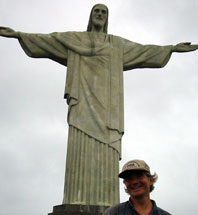
et bien sur les enfants des rues.
Dans les rues de Rio, la fête dur pendant une semaine. Il y a beaucoup
de podiums dans chaque quartier avec les groupes qui jouent jusqu'à
très tard dans la nuit. Je suis toujours surpris de voir les gens commençaient
à danser au premier coup de tambour.
Je suis resté à Rio pendant 6 jours. Un jour je suis monté
au Christo Redentor (photo). Cette statue surplombe Rio du haut de
la montagne (710m). La vue y est généralement spectaculaire
mais ce jour là il pleuvait et la brume enveloppait la montagne.
Mercredi 25 février.
J'ai
quitté Rio tôt ce matin là, tout heureux d'avoir tout mon
équipement avec moi (on ne m'avait rien volé) en direction de
Parati. Parati, 280 Km au sud-ouest de Rio, est l'une des plus jolies
villes
coloniales du Brésil (photo). Ce splendide petit village se situe entre
la mer et une montagne couverte de forêts tropicales. La mer, elle-même,
est envahie de centaine de petites îles. C'était un endroit parfait
pour se reposer après Rio. Je trouvais un hôtel raisonnable et
j'allais visiter la ville. A mon retour, la pluie faisait son apparition. Le
lendemain, c'était pire, la pluie m'isolait dans ma chambre. Les nuages,
remplis de pluie, semblaient toucher la mer. Le ciel était tellement
bouché que je ne pensais jamais revoir le soleil. Un
coup
d'œil dans le journal pour vérifier la météo n'arrangeait
rien. D'après ce que je comprenais, tout le sud du Brésil allait
être sous la pluie pour plusieurs jours. Cela ne m'arrangeait pas beaucoup
mais je voulais quand même reprendre la route.
Je me levais tôt le lendemain, enveloppé dans mes habits de pluie,
pour aller chercher ma moto. Je n'en croyais pas mes yeux, un ciel bleu parfait
et un soleil timide qui pointait son nez. Je prenais la route gaiement en prenant
soins d'enlever ma combinaison de pluie. La route suivait la côte et le
paysage me faisait penser à la côte d'azur. Je la suivais pendant
300 Km avant de quitter l'océan et de rejoindre Saõ Paulo. La
traversé de Saõ Paulo se déroulait sans problème
et je réussissais à gagner Curitiba dans la soirée
sans la moindre goutte de pluie. J'avais avalé 800 Km et mes saintes
fesses me le faisaient savoir. Elles me suppliaient d'arrêter et après
un bref débat j'acceptais.

Le
lendemain je réussissais à gagner Foz do Iguaçu
(680 Km). Une journée bien ensoleillée avec une température
entre 30 et 35 degrés. J'étais venu pour voir les magnifiques
chutes d'Iguaçu qui sont au même rang que les chutes du Niagara
ou celle de Victoria en Afrique. Celles-ci se trouvent exactement où
le Paraguay, l'Argentine et le Brésil se rencontrent. C'est ici que la
rivière Iguaçu plonge de 80m en 275 différentes cascades.
Le lendemain, je les visitais du côté Brésilien où
on les voit de
loin
puis je passais la frontière d'Argentine pour les visiter de prés.
Pas de problème pour passer la frontière. Je ne sais pas si je
la passais avec plaisir ou avec regret car c'est la dernière de mon voyage.
La fin de mon voyage approche, il ne me reste plus qu'à gagner Buenos
Aires mais qui sait, il y a encore de la route à faire et tout peut arriver.
Ne manquez pas la conclusion de ce périple, prochainement et ici même.
Au revoir.
Here is a selection of photos
from the Carnaval.
Voici une collection de photos du Carnaval.
My all time favorite.
Ma préférée.
Back to reality, postcard
from Parati.
Retour à la réalité, carte postale de Parati.
Iguacu falls.
Les cascades d'Iguacu.
 |
 |
 |
 |
 |
 |
 |
 |
 |
 |
 |
 |
 |
|
JOURNAL 34.
02/03/04 . Brazil . Total mileage
so far 67,245km .
(Pour la version française
du journal, allez au bas de la page ou cliquez
içi.
Pour revenir à la version française du site, cliquez
sur Français)
How
can you help make Ride4Kids a worthwhile project? To find out,
click here.
|
|























